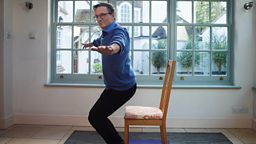Michael Mosley: Five ways to unwind and find Deep Calm
Life comes at us fast. Thoughts and ideas, hopes and worries – it is all too easy to get caught up in the whirlwind. And it can be hard to switch off our busy brains at the end of the day. But, deep within, we do have the capacity to achieve an inner peace.
My new immersive podcast series, Deep Calm – with Michael Mosley, is on hand to help you tap into a hidden system inside – your relaxation response. In each episode, designed to help you let go and unwind, I’ll guide you through a different, scientifically-proven technique to activate this built-in relaxation system and open the door to that calmer place within.
Here are my five ways to find inner stillness and calm…
1. Use your breath
One of the best and simplest ways to activate your relaxation response is to slow your breathing right down.
Aim for around six breaths per minute. This is the sweet spot where your breathing rate aligns with other rhythms in the body.
The body’s relaxation response is part of the parasympathetic nervous system – a network of nerve fibres that connects and regulates organs throughout your body. Activating this system helps you to rest and digest, repair and restore, renew, recharge and reset.
When you breathe out, you stimulate the “primary highway for the parasympathetic nervous system,” explains neuroscientist Mara Mather from the University of Southern California. This is known as the vagus nerve. By breathing deeply, you stretch your lungs, which results in a strong message being sent, via the vagus nerve, to your heart to slow down the rate of beating. This in turn lowers your blood pressure and, crucially, calms brain activity. It also stimulates the release of neurotransmitters that can bring a sense of positivity and peace.
Aim for around six breaths per minute. Although it can vary a little from person to person, this is the sweet spot where your breathing rate aligns with other rhythms in the body. I find it helps to do box breathing – in for a count of four, hold for two and out for four – but find what feels right for you.
Slowing your breathing like this for just five minutes a day has been shown to improve mood and reduce anxiety.
> Learn more about the calming effects of slowing your breath
-
![]()
How to reset your brain with your breathing
Michael Mosley looks at the surprising science around the effect of your breath on your health and wellbeing.
2. Tense and then relax your muscles
Relaxation isn’t just a state of mind, it’s a whole-body thing. As Ian Robertson, professor at Trinity College Dublin, explains, we don’t express emotions just inside our head, “our brain has emotions that manifest themselves in our body.”
So, by making conscious changes to the body, we can trick the brain into feeling less stressed, in turn relaxing the body further.
One effective technique is progressive muscle relaxation. This means deliberately tensing and then relaxing individual muscle groups in your body, which sends signals back to your brain, to change the way you think and feel. Studies show it can lower the stress hormone cortisol, boost your mood and reduce anxiety. As little as 15 minutes a day can be hugely beneficial.
To give it a go, start with your feet and systematically work your way up the body using your breath as a guide. Try making a tight fist, holding it, and then letting go – feeling the tension melt away and your mind start to clear…
> Hear more about the benefits of progressive muscle relaxation

The Vagus nerve: "Primary highway for the parasympathetic nervous system"
Neuroscientist Mara Mather explains how messages from this nerve calm brain activity.
3. Use your imagination
When you imagine yourself somewhere peaceful and safe, you can activate your body’s relaxation response: lowering your heart rate and blood pressure, clearing your mind and lifting your mood.
The technique is called guided imagery. Think of a place where you can really relax and be yourself. It might be your favourite beach, a woodland, or a flower meadow. Now simply imagine yourself there. When you envisage the sights, smells and textures of that happy setting it can activate your brain as if you’re actually experiencing those things.
Katarzyna Zemla, from SWPS University in Warsaw, explains how guided imagery can actually alter your brainwaves – from beta brainwaves, seen during normal day-to-day activity, to alpha brainwaves, which are a sign of deep relaxation.
The good news is anyone can benefit, says Katarzyna: “You don’t have to practice it. You don’t have to wait long for getting the results. It’s really easy to dive into guided imagery and feel comfortable and relaxed even after the first session.”
> Learn more about how to practice guided imagery
4. Harness the power of nature
You might have found that when you’re feeling tense, getting out into the natural world can really help. Our body has powerful physiological responses to the sights, sounds and sensation of being in nature – it can stimulate our relaxation response.
There’s evidence that just 15 minutes spent in a forest can lower your blood pressure, heart rate and levels of the stress hormone cortisol, leaving you feeling calmer and more refreshed. Other studies have shown that being in nature for an hour or two at a time can reduce activity in stress-related regions of the brain. And if you’re not able to get out to a forest, research has shown that simply looking at flowers, or even images of natural environments, can have similar relaxing effects.
What is it about the natural world that is so calming? Richard Taylor, professor at the University of Oregon, believes it’s to do with the repeating patterns in nature: fractals. Clouds, rivers, coastlines and trees are all fractal. If you stare at these patterns that are very prevalent in nature, it can reduce your stress levels by up to 60%, he states. “Look at nature and it gives you this stress reduction for free.”
So, head somewhere green and take it all in. Look up at the canopy, smell the flowers, listen to the birdsong. Put plants in your room or look at photos of natural scenes – it will all help to activate your relaxation response.
> Hear more about the relaxing power of nature

5. Listen to music
Music can be an effective tool for tapping into your body’s relaxation response; really listening to some relaxing music can bring down your heart rate, melt away negative thoughts and even help to alleviate pain.

In Deep Calm, Stefan Koelsch, professor at the University of Bergen in Norway, explains how sound waves travel into the ear canal and are converted into signals that enter the brain. From there, further signals are sent via the parasympathetic nervous system to our other organs, with restful and restorative effects. “Numerous scientific studies showed that when we listen to calming music our heart rate decreases, our blood pressure decreases and our breathing rate decreases,” he states.
Music is also a good way of breaking free of negative thought loops – those worrying or critical thoughts that take a hold and go round and round in your mind. When we listen to relaxing music, and perhaps breath in and out while tapping or counting to the beat, our minds are absorbed and don’t have the resources left for negative thoughts.
So, what counts as “relaxing” music? The sounds are slower, have less energy, fewer high frequency components and fewer pitch variations. Think repetitive melodies with a soft beat. Lullabies, which sound similar across cultures, are a good example. “The global similarity tells us our brains are wired by nature to be receptible to calming sounds,” says Stefan. “It’s biologically coded. We don’t have to learn it; we are born with it.”
So, put on some calming music, get comfy so you can really focus on it, and try gently tapping to the beat. Even a few minutes can be regenerative.
> Discover more about the relaxing properties of music
If you'd like some help winding down and tapping into your inner peace, subscribe to my 91�ȱ� Radio 4 podcast, Deep Calm – with Michael Mosley.
-
![]()
Just One Thing: Listen to Music
In this episode of his podcast, Michael explores the power of music, from reducing pain to forging strong family relationships.



















































